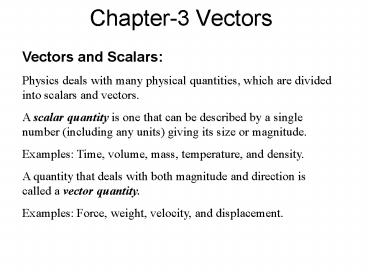Chapter-3 Vectors - PowerPoint PPT Presentation
Title:
Chapter-3 Vectors
Description:
Chapter-3 Vectors Vectors and Scalars: Physics deals with many physical quantities, which are divided into scalars and vectors. A scalar quantity is one that can be ... – PowerPoint PPT presentation
Number of Views:243
Avg rating:3.0/5.0
Title: Chapter-3 Vectors
1
Chapter-3 Vectors
Vectors and Scalars Physics deals with many
physical quantities, which are divided into
scalars and vectors. A scalar quantity is one
that can be described by a single number
(including any units) giving its size or
magnitude. Examples Time, volume, mass,
temperature, and density. A quantity that deals
with both magnitude and direction is called a
vector quantity. Examples Force, weight,
velocity, and displacement.
2
Vector Illustration
The length of the vector arrow is proportional to
the magnitude of the vector and the arrow
represents the direction. In the text, bold face
is used for vectors and italics is used for
scalars. When hand written an arrow is placed
above the symbol. A vector can be shifted without
changing its value if its magnitude and direction
are not changed.
3
3.3 Adding Vectors Geometrically
Vector Subtraction
P8. A person walks in the following pattern 3.1
km north, then 2.4 km west, and finally 5.2 km
south. (a) Sketch the vector diagram that
represents this motion. (b) How far and (c) in
what direction would a bird fly in a straight
line from the same starting point to the same
final point?
4
3.4 Components of Vectors
- Adding vectors geometrically can be tedious. A
neater and easier technique involves components
of vectors. - A component of a vector is the projection of the
vector on an axis.
Find the x and y components of the following
displacements a. 12.0 m, at 10.00
counterclockwise from y.b. 8.00 m, at 20.00
clockwise from y.
5
3.5 Unit Vectors
- A unit vector is a vector that has a magnitude of
exactly 1 and points in a particular direction. - Unit vectors in a right-handed coordinate system
are shown below.
P56. Find the sum of the following four vectors
in (a) unit-vector notation, and as (b) a
magnitude and (c) an angle relative to x.































